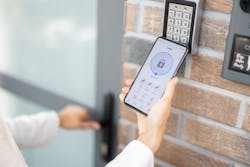Executive Insights: A conversation with Zerv CEO Cody Horchak
When you’ve made your living in the financial sector, time really is money. So, when Cody Horchak decided to move his management skills into the technology industry, he wanted to impact areas of business he oftentimes found slowing him down – security in general and access control systems in particular. Horchak’s obsession with efficiency and his desire to maximize business operations in organizations that directly affected him and his colleagues in their everyday lives pushed him into an out-of-the-box approach on how users interface with access control in various settings like hotels and resorts, commercial buildings, multifamily facilities and parking structures.
His new company would eliminate the barriers many access control systems presented to users and would make the process easier. With that mission in mind, Horchak and his investors launched Zerv in 2018, with the idea of driving digital solutions into the physical security world and at the same time simplifying ease of access.
Realizing users are extremely protective of their mobile devices, Zerv can capitalize on the ease of maintaining digital access credentials across the organization from enrollment to credential revocation, in addition to employing the built-in protection of mobile devices like facial recognition, password protection and other biometric screening capabilities.
Recently I had the opportunity to discuss the trends affecting an access control market driven by digital and mobile technologies with Horchak, along with how he sees Zerv’s position in the market.
Steve Lasky: You're a non-technologist. So, talk about how this efficiency and time obsession has driven you to start your new endeavor several years ago.Cody Horchak: How do you put control at your fingertips? Those fingertips being your mobile phone, how do we engage and make your mobile phone the key to all physical assets around you? You can now download our {Zerv} app just like you can download Instagram and be connected with the digital world, and it lets you be connected with the physical world. it's not so much access control, it's the future of being able to control the access and the assets you own in an efficient and streamlined method.
Lasky: There has been a drive toward migrating mobile applications to physical security for several years. How has Zerv taken some of these technical nuances and engineered them into a solution that makes it work with digital mobile devices?
Horchak: Every physical key that you have has an identifier. Even a brass key is an identifier of being authorized to unlock a particular lock. Zerv can't support a physical key that you insert and turn a cylinder to unlock a door, but we can support a contactless infrastructure. You have an access badge or a fob or a hangtag or transponder. Access badges are used to get into hotel rooms and office spaces, fobs are used to get into gyms, transponders are used to get on toll roads and hang tags are used in parking garages. All of these unique applications require a digital transmission of information from that technology to something that's reading it. Zerv found a way to clone the data that is stored on that credential. We don't do the same communication encryption between that (card) and the reader, but we take the raw data off of (a card or fob) and we inject it in a much more secure way into the existing reader, leveraging more modern, very secure and active communication, like Bluetooth, near-field communication (NFC) or ultra-wideband, which allows for a significant amount of increased security.
It is common to be able to take the physical badge that gets you into your office to any 7-Eleven in the U.S. and clone it for twenty dollars. All of a sudden you have multiple access badges. Reserve technology can't (be done with Zerv) because we're securing it into a phone. You can share it with people you are authorized to share it with, yes, but that also can be restricted based on what the business appetite is. Also, your physical credential, your fob, your toll pass, your car keys; only you check for them when you need them. On average, your access badge to get into your office will be checked three times a day. When you go in, when you use the restroom, and when you go to lunch. You don't check for your access badge when you leave your office because you don't need it to get back in. You also only check for your car keys when you're looking to drive your car. On average, you check your phone's proximity to you once every three minutes -- two to three minutes on average. So, right there you’ve enhanced security.
Lasky: Talk a little bit about how you have partnered with legacy access control systems to seamlessly put your solution onto their platforms. And is that part of the strategy?
Horchak: A lot of people have started to come to us for a handful of reasons. They might be an access controller company, or they might be a reader company, or they might be a tenant experience application or something similar, that needs to be able to natively communicate between a phone and that reader. But there are various influences affecting relationships today. There are long lead times with some of the largest manufacturers of readers around the world. Some, like the more well-known companies, are pushing 72-week lead times on readers. The semiconductor industry, which makes those physical plastic cards, are also pushing 72-week lead times because of major supply chain shortages and labor shortages.
So, a lot of people are now coming to us and asking, "Hey, can we partner with Zerv to facilitate a mobile experience as a retrofit to the legacy system, because we don't have the inventory to rip and replace today?"
People who used to see us as competitive are now coming to us and asking, "Hey, can you help us?" But there are still some incumbents that really don't want us to be successful as a startup…we say that with a good product comes good competition. And good competition makes this fun because we're trying to make the world inclusive. A lot of people are now starting to see the opportunity that partnering with Zerv brings when they are streamlining engagement to facilitate mobile access in a world where the supply chain is impacting things,
Lasky: Has the pandemic crush helped your company with its technology advancement?
Horchak: This technology was available before the pandemic started, and it was perceived as a luxury product prior to that. Since the pandemic's hit, it definitely has accelerated adoption. Early on in the pandemic, everyone wanted touchless access. Everybody was afraid to touch doorknobs and clients asked if they could make mobile phones interact with readers and put in automatic door openers. While that actually has not really continued so much in the past year, last year it was a knee-jerk response to the global pandemic where the reaction was, "Hey, let's remove touch points and therefore, stop the spread."
Now, a lot of the adoption that's happening relates to supply chain shortages and labor shortages. We're getting a lot of inquiries from companies that tell us we now need to do what we did previously with 20 people with only 12 people because we can't fill these other jobs. Coincidentally enough, though, the supply chain and labor shortages are what is driving the quick adoption of touchless automated technology because it allows you to automate things like visitor management. You don't need to stop at a security desk anymore. You can send a (digital) credential that gets a person through the turnstiles, up the elevators and into their meeting in a secure fashion.
Lasky: Mobile applications are certainly driving the physical security market, so your company is in an advantageous position for growth, is that your assessment?
Horchak: Zerv is compatible with everyone. All of those that connect different access control systems from the backend brain perspective, need mobile credentials linked to the reader. We collaborate well with them all, including the reader companies. But these readers need to be interoperable with buildings like Rockefeller Center which has 196 different access control systems in it. They need a unified experience. So, we continue to support the credential and reader transaction. We just bring them all together under that single unified experience, and it's super non-competitive. Most companies see us as an enhancement.
And then as the world continues to adopt mobile credentials, and as Apple Wallet applications continue to expand…you still need that legacy reader to read Apple Wallet. We are the quickest way to enable that legacy reader to read it, especially now since some of the bigger reader manufacturers are pushing very long lead times. We can retrofit legacy as they transition out and change out the readers.
About the Author: Steve Lasky is a 34-year veteran of the security industry and an award-winning journalist. He is the editorial director of the Endeavor Business Media Security Group, which includes magazines Security Technology Executive, Security Business and Locksmith Ledger International and top-rated webportal SecurityInfoWatch.com. Steve can be reached at [email protected].
About the Author
Steve Lasky
Editorial Director, Editor-in-Chief/Security Technology Executive
Steve Lasky is Editorial Director of the Endeavor Business Media Security Group, which includes SecurityInfoWatch.com, as well as Security Business, Security Technology Executive, and Locksmith Ledger magazines. He is also the host of the SecurityDNA podcast series. Reach him at [email protected].



